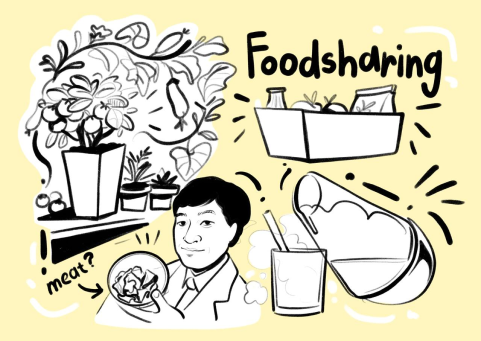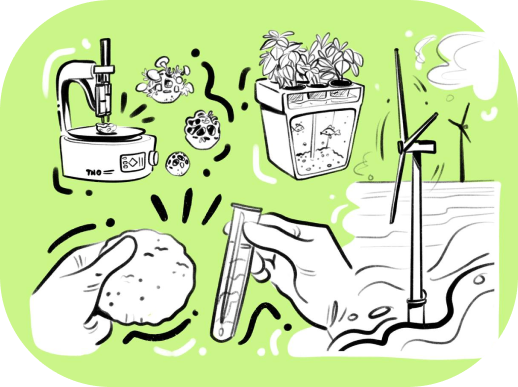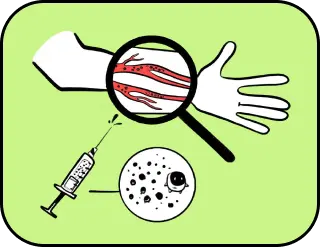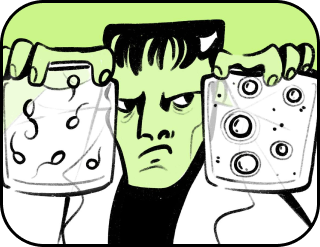How to Create an Abundant Farm of the Future
The world of the future has arrived! Earth’s population is rapidly growing, while resources for sustenance are becoming increasingly scarce. People are desperately trying to find a way out of this situation, but unfortunately, their efforts are in vain.
In one of the world’s megacities, people stand in endless lines for the meagre remnants of food. Each person, jostling and quarrelling, tries to grab their share: some attempt to bribe the guards for more, while others simply give up and lie on the ground, resigned to their fate.
Our hero, John, despite all the difficulties, maintains a balanced optimism and a healthy sense of humour. He stands in line, observing human attempts to secure food and quietly chuckles: “So, my friends, who will give up first and start eating their neighbour?”
John’s fellow line-goers cast sideways glances at him, but he merely shrugs: “What can you do? This is the reality of our time. Soon we’ll all be living on energy pills, and real food will become a luxury.”
John imagines a future where people go to restaurants to be served tiny portions of “real” food, with waiters narrating the unique origin of each ingredient. “Now that’s living!” John dreams, as his place in line slowly inches forward.
But John, lost in his thoughts, didn’t yet realise that his words had caught the attention of the people around him. After all, they had plenty of time for philosophical discussions and searching for truth. “Why don’t we try to find a solution to save humanity: a practical one or perhaps a provocatively technological one?”
John pondered while listening to the buzzing voices of the people around him. The line, trying to distract itself from the dull boredom, split into groups enthusiastically discussing “hungry” topics. Everyone was certain that our planet stood on the brink of monumental changes. With each passing year, Earth’s population grows, and along with it, the demand for agricultural land. However, this process inexorably leads us to a dead end, to a vicious cycle of problems that only worsen. Yet, as it turns out, there are solutions that can dramatically change the situation.
“City farming,” John thought to himself.
“City farming, or urban agriculture, isn’t just about growing plants on a balcony in urban settings — it’s a revolution in agrotechnology. Thanks to modern advancements like the automation of lighting, temperature control, and watering, we can grow fresh vegetables and fruits right at home, without the need for soil or natural sunlight.
But the wonders don’t stop there. The rise of vertical farms, where “beds” of plants are stacked one above the other, vertically, allows not only for space-saving but also significantly increases crop yields.
As it turns out, tomatoes, peppers, lettuce, mushrooms, and many other crops thrive in controlled microclimate systems equipped in many city farms. These systems ensure the farm’s climate is constantly kept in favourable conditions, leading to higher yields. At the same time, city farms protect the environment by reducing reliance on synthetic chemicals and optimising water use. This makes it possible to grow food even in challenging conditions with limited resources.
There are many benefits to such urban gardens — they not only solve the issue of land scarcity but also bring numerous ecological and financial advantages. Local production reduces carbon emissions associated with transportation, allowing people to access fresh, affordable food. Moreover, these eco-friendly gardens create new jobs and stimulate the development of the local economy.
Of course, eco-gardens are unlikely to fully replace traditional agriculture, but they can serve as one of the key answers to the global challenges and crises humanity will face in the near future. Thanks to closed systems that don’t depend on weather conditions, we might even be able to colonise other planets…”
John’s dreams and the buzzing chatter of his fellow citizens were interrupted by a frail old man standing nearby, with wise, kind eyes and hands blackened from labor:
“You all strive for the future because you’ve grown accustomed to artificial things. I, on the other hand, have always stood for everything natural, grown by my own hands, until I realised that naturalness can also harm our planet. I believe that livestock farming is not the path to a well-fed future but true resource vampirism! Think about it: we spend vast amounts of land, water, and food to raise animals, only to then devour them with gusto. No one, upon entering a restaurant, would order a dish made of the waiter himself.”
“This man is right!” John exclaimed. “Plants are the true workaholics of the planet. They draw energy directly from the Sun and Earth and then share it with others. But animals are mere freeloaders, parasitising on plants, and we, humans, then parasitise on these parasites! It’s like a matryoshka of living beings, where everyone is eating someone else.”
“Exactly!” the queue buzzed. “To feed one person with fish, you need 300 fish. And to grow those 300 fish, you need 90,000 tadpoles, 27 million insects, and a whole ton of plants! Can you imagine how many resources are wasted? If we just ate the plants directly, we could feed a thousand times more people! It’s like trying to build a pyramid out of blocks, but instead, you start building another pyramid inside the first one, and then another one inside the second. It’s a pointless waste of resources!”
“Exactly!” the merchandisers agreed. “In this situation, the ‘cherry on top’ is that with a plant-based diet, one hectare of land can feed 17 people, while with animal farming, it can only feed 5.5. We’re just squandering the planet’s resources by raising animals and sending them to slaughter. It’s like trying to heat your house by burning money — expensive and completely inefficient.”
“Maybe there’s a reason we’ve gradually been forced to abandon this livestock madness and move towards a plant-based diet?” the store workers asked. “Otherwise, we’ll all have to start eating air soon because there won’t be any other resources left on the planet. Or we’ll have to start raising cows on the Moon, but that’s another story.”
“Have you ever wondered where all this endless food disappears to?” the merchandisers continued the interesting conversation. “No, not into our stomachs, but into the trash bins! Turns out, stores and cafés love throwing away food that’s about to expire or has slightly dented packaging. And it’s not just them. Even our homemakers are happy to toss out leftover soup or extra potatoes from yesterday.”
“Imagine this: in large countries like Russia, 17 million tons of food waste are thrown away every year!” the same old man calmly stated. “That’s enough to feed an army of 30 million people. That’s two Zimbabwes! Environmental activists couldn’t ignore such disgrace and came up with a brilliant solution — food sharing.”
“That man is right again!” exclaimed John, the lover of life solutions. “Food sharing is a movement that helps people get food for free or share it. It sounds like something out of science fiction, but it’s real! People simply post on social media that they have extra bread rolls, apples, or even whole pots of borscht, and there are always people eager to take them. Stores and cafés are happy to give away what they no longer need. Saving money, caring for the environment, and delicious food — what more could you want?”
“Food sharing started in Germany back in 2012, and Russia only learned about it three years later, in 2015. Today, there are entire communities around the world where you can find everything from fresh vegetables to homemade baked goods.”
“Impossible Foods studied meat at the molecular level,” John overheard a nearby conversation, “asking questions like why it changes colour when cooked, why it sizzles when fried, and why it smells the way it does. In the end, these specialists recreate the meat and its aroma by combining different components, all sourced from plant materials.”
“Forget boring medicines — soon, we might be able to enjoy the taste of food with the help of augmented reality!” shouted an operator from the far corner of the store. “It could be specific lighting or a hologram overlaid on the food… We recently saw this in Blade Runner 2049.”
“Or maybe we’ll have ‘DIY’ food technology, which is especially likely when we start colonising outer space,” John began to dream. “At its core would be standard kits: a bottle of water enriched with minerals and vitamins, plus a tasteless protein and carbohydrate brick. Using a special device, like a compact autoclave, you’d be able to ‘colour’ your food with different flavours. From the same brick, you could make chicken pâté, chocolate mousse, or vegetable stew.”
“That’s not even the limit of researchers’ imagination,” whispered a homeless man with a wild look in his eyes. He was a local store celebrity. “You have no idea what you can make nutrients from! For example, recently, some reliable sources mentioned a doctor named Mitsuyuki Ikeda. He discovered a bacterium that processes waste into protein, creating something very similar to meat. The product has already earned the unappetising name — ‘shitburger.'”
“Scientists from Lappeenranta University of Technology in Finland have discovered a cheap way to extract protein from bacteria,” the old man chimed in, continuing the conversation. “Austrian designer Katharina Unger suggested using mushrooms that decompose plastic for food, especially considering that the oceans are already filled with vast amounts of this ‘raw material.'”
“Did you know that instead of regular food, we could be eating steam or smoke?” shouted the local rocker Harry, who had stopped by the store for an energy drink. “There’s already a device called ‘Le Whaf’ that allows you to get nutrients straight from the air. If you don’t have time to stop for a snack, there’s a special patch that can nourish your body with all the necessary substances. There’s also a healthy chewing gum packed with beneficial supplements. You could even implant a reservoir under your skin for nutrient cocktails. And of course, the most futuristic idea is from biologist Chuck Fisher, who suggests we could get energy directly from the Sun! Tiny algae under our skin would produce food for us. It’s just a dream for now, but who knows — maybe one day we’ll fully switch to this kind of nourishment.”

“Do you know what mushroom abundance is?” asked an elegant lady, a professor from the University of Edinburgh. “These amazing organisms are still not fully understood. Edible mushrooms combine nutritional value, low calories, and even medicinal properties, but they are also economically advantageous: mushrooms have high productivity, can grow on various substrates, and don’t need specialised facilities. For example, scientist Chloe Rutzerveld proposed combining mushrooms with advanced technologies by creating a 3D food printer called Edible Growth. This unique device can print miniature snacks containing mushroom spores and plant seeds. Of course, after printing, you’ll have to wait 5-6 days for the ingredients to grow.”
“Well, we’ve waited longer than that,” smiled John, joining the technological discussion. “Is everyone ready to be part of the exciting ‘mushroom revolution’?”
“Forget all your ancient ideas about food, farming, and gardens. Wind farms are the new paradise for marine life!” the old man unexpectedly said. “Have you ever dreamed of growing fish and vegetables simultaneously? This crazy plan has already been implemented through an ancient concept called aquaponics. You plant your favourite vegetables, while happy fish swim nearby. These clever creatures not only beautify your garden but also fertilise it with their waste. In return, the plants purify the water for the fish. It’s a true symbiosis, and environmentally friendly too.”
“The idea of aquaponics, as it turns out, emerged hundreds of years ago,” agreed a female scientist. “Farmers in Southeast Asia started adding tilapia to their rice fields. Imagine their surprise when crop yields skyrocketed! Apparently, the fish knew what they were doing! If we’re dreaming of a self-sustaining garden of the future, where plants and fish live in harmony, it’s time to take a closer look at aquaponics.”
“Or imagine this: huge wind turbines towering above the waves, transformed into a true underwater oasis! Scientists from Denmark decided it was time to make the most of the previously unused seabed,” John excitedly informed. “The Kriegers Flak wind farm, Denmark’s largest, is owned by energy giant Vattenfall. Together with Aarhus University, they decided to turn this area into a real marine garden. Eighteen months after the experiment began, the scientists harvested their first crop: seaweed and plump mussels!”
“Competition for space on land and sea is growing, so why not produce both green energy and food for the growing population on the same territory?” smiled the curious old man.
“What’s even more fascinating is that these marine crops can be grown with virtually no maintenance. They absorb nutrients directly from the sea and even capture carbon dioxide, helping to slow global warming. You just hang ribbons with mussels between the turbine supports and wait for the harvest,” gasped an out-of-breath student. “Previously, these areas were unused — no ships or birds went there. Now, wind farms have become an underwater paradise! Scientists have calculated that if only 10% of Denmark’s wind farm areas were utilised, they could supply seafood to the entire population.”
“Wow! It seems wind turbines aren’t just a source of clean energy, but real marine gardens of the future. Who would have thought?” said a floor worker who overheard the conversation.
“Imagine soon being able to enjoy a juicy steak or a delicious chicken breast, not raised on a farm, but grown in a lab! Yes, that’s no joke — labs worldwide are working on ‘cultured meat’ and making great strides,” John said proudly. “A few years ago, the first lab-grown burger cost a fortune — 250,000 euros! But progress doesn’t stop, and today, a steak from Dutch experts costs just $450 per 100 grams. Specialists from Future Meat have even managed to grow chicken at just over a dollar per portion.”
“Israel is ahead of the game in this field — local scientists even managed to grow meat in space,” shared a young man who had just joined the conversation, jotting something down in his notebook. “You’re flying to the ISS, and a space stewardess serves you a lab-grown steak for lunch. I wonder how it turned out in zero gravity?”
“According to futurists, by 2030, natural meat could drop in price by as much as 70%. So, soon enough, we might be able to treat ourselves to a juicy lab-grown burger. We just have to wait until it’s allowed to be sold outside of Singapore. Who knows, maybe in the future, we’ll be going to ‘Lab-Grown Meat’ restaurants instead of traditional steakhouses.”
The more John thought about what he had heard, the more he realized the world had already changed: technology was rapidly transforming life, and people were figuring out how to harness it.
Technologies, working in harmony with changing tastes and preferences, are capable of completely transforming our relationship with food. Personalised algorithms are learning to select the perfect recipes, taking into account tastes, the body’s needs, and even mood. And a 3D printer can bring the boldest culinary fantasies to life.
Food is no longer just a necessity — it’s becoming a source of pleasure, inspiration, and personal growth. That’s the future we should aim for. Only people who are open to change and full of curiosity will push humanity forward, creating something new. But it would be nice if it were also beneficial.
Meanwhile, John stood in line just to eat and survive.

The cell divides into the nucleus and cytoplasm. Our journal divides into interesting facts and discoveries.
Thank you!




